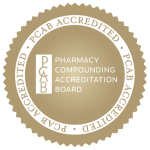Based on the data from the NIH, pain affects more Americans than diabetes, heart disease and cancer combined. It is cited as the most common reason Americans access the health care system. And It is a leading cause of disability and it is a major contributor to health care costs.
FDA regulations and drug manufacturers marketing tactics have allowed practitioners to prescribe opioid drugs too much, too easily and now we are dealing with a national health crisis of multi-factorial consequences – the opioid addiction epidemic. The whole nation – from health organizations to economists, to politicians – is in search of a solution to help ease this crisis.
Did you know that using pharmaceutical compounded medication can be part of that solution?
Prescribing compounded pain medication is beneficial for your patients, your practice and here is how:
- Every patient is a unique individual, with unique medication needs. The location of the pain, the intensity of the pain, the duration of the pain, the cause of the pain is different from patient to patient. Pharmaceutical compounding allows you to custom formulate the pain prescription precisely tailored for your patient’s need based on all these factors. Several pain management professional groups created algorithm tables based on various criteria on what to prescribe, when to prescribe it and how to formulate the prescription for a compounded medication.
- In most cases, compounded pain medications can be transdermal. There is abundant scientific data that supports their efficacy. Transdermal pain medications come with a myriad of benefits for the patient. Here are some of them:
- Precise strengths and drug combinations,
- Ability to combine multiple drugs with various mechanisms of action
- Application directly at the site of pain
- Convenience of medication administration for the patient
- Potential for less systemic absorption and minimization of side effects
- More convenience and better adherence to treatment regimen
- Easy adjustment or titration to meet patient needs
- Minimization of abuse and addiction risk
- The benefits your patients can get from compounded transdermal pain medications will be reflected as benefits for your practice. Customized medications provide better adherence to the treatment and lead to better clinical outcome with secondary economic advantages. This means more satisfied, happier patients.
- Contrary to common belief, compounded pain medications are a cost-effective solution for the patient. When customized medication is a combination of several drugs, the patient will frequently pay less for the whole combination than the combined co-payments for each drug.
You can get more detailed information about the algorithm used in formulating prescriptions for compounded pain medications from a reliable and experienced compounding pharmacy.
If you need help with hard to treat cases, you should contact your compounding pharmacist for a pertinent advice.
For questions about supporting scientific data, a trustworthy compounding pharmacy can provide the answers you are looking for.
The only thing you need to do is to choose the right compounding pharmacy to be your long-term, trusted ally in helping your patients with customized pain management solutions.
Let HALDEY Pharmaceutical Compounding be that choice for you. Contact us today for an evaluation of your compounding needs.
References:
- Pain Physician.2014 Jan-Feb;17(1):81-94. Medication compliance in patients with chronic pain. Kipping K1, Maier C, Bussemas HH, Schwarzer A.
- Algorithm for Chronic Pain (by Mode of Action) Jones M. Chronic Neuropathic Pain: Pharmacological Interventions in the New Millenium – A Theory of Efficacy. International Journal of Pharmaceutical Compounding. Jan/Feb 2000; 4(1): 6-15.
- Jones M. Clinical Nuggets and Pearls: Chronic Neuropathic Pain and Opioid Tolerance. International Journal of Pharmaceutical Compounding. Jan/Feb 2002; 6(1): 4-6.
- Pud D, Eisenberg E, Spitzer A, Adler R, Fried G, Yarnitsky D. The NMDA receptor antagonist amantadine reduces surgical neuropathic pain in cancer patients: a double blind, randomized, placebo controlled trial. Pain. 1998 Apr;75(2-3):349-54.
- Bennett GJ. Update on the neurophysiology of pain transmission and modulation: focus on the NMDA-receptor. J Pain Symptom Manage. 2000 Jan;19(1 Suppl):S2-6.
- Sawynok J. Topical analgesics in neuropathic pain. Curr Pharm Des. 2005;11(23):2995-3004.
- de Leon-Casasola OA. Multimodal approaches to the management of neuropathic pain: the role of topical analgesia. J Pain Symptom Manage. 2007 Mar;33(3):356-64.
- Finnerup NB, Otto M, McQuay HJ, Jensen TS, Sindrup SH. Algorithm for neuropathic pain treatment: an evidence based proposal. Pain. 2005 Dec 5;118(3):289-305. Epub 2005 Oct 6.
- Lussier D, Huskey AG, Portenoy RK. Adjuvant analgesics in cancer pain management. Oncologist. 2004;9(5):571- 91.
![Shoulder-problems-that-wont-go-away-resize1 [ File # csp11032384, License # 2124206 ]
Licensed through http://www.canstockphoto.com in accordance with the End User License Agreement (http://www.canstockphoto.com/legal.php)
(c) Can Stock Photo Inc. / pixologic](https://hcompound.com/wp-content/uploads/elementor/thumbs/Shoulder-problems-that-wont-go-away-resize1-p202oew6gp7rpiswr0v9eraq1any4rld4dlrnrg2o8.jpg)



